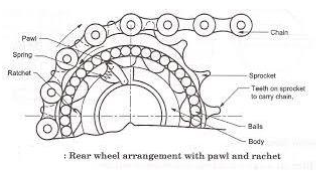Explain the working of freewheel mechanism of bicycle with sketch.
A freewheel mechanism on a bicycle allows the rear wheel to turn faster than the pedals. If there is no freewheel on a bicycle, a simple ride could be exhausting, because one could never stop pumping the pedals. And going downhill would be downright dangerous, because the pedals would turn on their own, faster than one could keep up with them.

Power Train of a bicycle: The power train of a simple bicycle consists of a pair of pedals, two sprockets and a chain. The pedals are affixed to one sprocket — the front sprocket, which is mounted to the bike below the seat. The second sprocket is connected to the hub of the rear wheel. The chain connects the two sprockets. When you turn the pedals, the front sprocket turns. The chain transfers that rotation to the rear sprocket, which turns the rear wheel, and the bicycle moves forward. The faster you turn the pedals, the faster the rear wheel goes, and the faster the bike goes.
Coasting: At some point — when going downhill, for instance — speed is high enough so that the rear wheel is turning faster than the pedals. That's when coasting: we stop working the pedals and let the bike's momentum keep moving forward. It's the freewheel that makes this possible. On a bicycle, instead of being affixed to the wheel, the rear sprocket is mounted on a freewheel mechanism, which is either built into the hub of the wheel — a "freehub" — or attached to the hub, making it a true freewheel.
Now when you have to move forward, the pawl acts like a hook and gets locked with the teeth - called ratchet and transmits the torque. The complete mechanism is called ratchet and pawl mechanism.
But when you reverse pedal, it falls back and becomes "free". A spring prevents it from falling permanently. This is the reason why you hear the distinct "click-click" sound when you reverse pedal. Also, there are multiple "pawls" placed along the circumference too.
